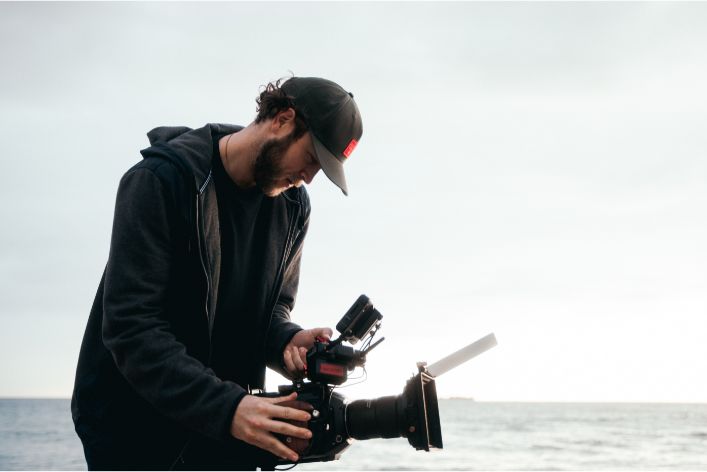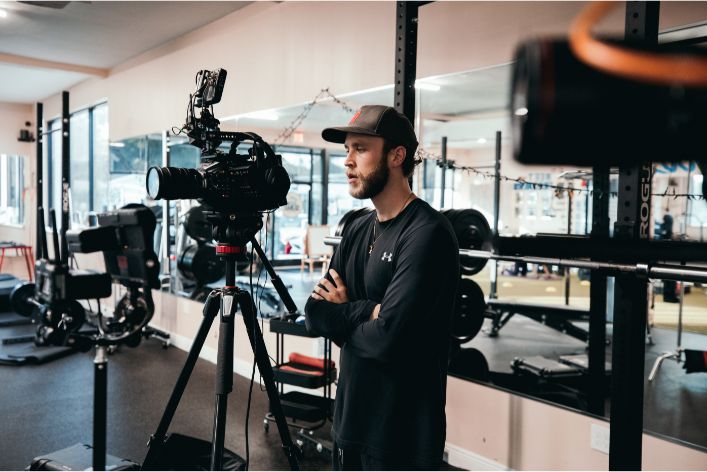Filmmaking is the art of creating a film, from the script to the final product. It combines the creative vision of individuals from various disciplines, including directing, cinematography, writing, sound design, and editing. The process of going from script to screen involves multiple stages, including pre-production, production, and post-production. Each person involved in the process, from the writer to the director, plays a vital role in bringing the film to life.

The pre-production phase is crucial and involves script revisions, casting actors, scouting locations, and preparing the crew and equipment. During production, the filming takes place, and all the elements come together to create a visual story. Post-production includes editing, sound mixing, and visual effects, which bring the final product to its intended form.
The writer creates the script, which is the foundation of the film. The director interprets the script and brings their creative vision to the screen. The cinematographer works with the director to capture the visuals that the director imagined. Sound designers create the sound effects, Foley, and music, which complement the visuals. Editors piece together all the shots to form a cohesive story, and the post-production team adds the final touches to the film.
In summary, filmmaking is a collaborative art form that requires the combined efforts of many talented individuals. Each person involved plays a vital role in creating the final product and bringing the script to life on the screen. The different stages of filmmaking, including pre-production, production, and post-production, are all essential for creating a high-quality film.
Read: Producers Guild of America’s Influence on TV Shows
Pre-Production
Pre-production is the crucial first step in the filmmaking process. It is the planning and preparation phase, where all creative decisions are made, resources are allocated, and logistics are figured out. Without it, a film can quickly veer off course and become a disaster.
The Different Stages of Pre-Production:
- Screenwriting: This is where the story is developed, characters are created, and the dialogue is written. A good screenplay is the foundation of a successful film.
- Storyboarding: Once the script is complete, a visual representation of it is created through storyboarding. This helps the director and crew to visualize the shots and plan the blocking.
- Casting: Choosing the right actors is a critical part of any successful film. The casting director will audition actors and select the best fit for each role.
- Location Scouting: The locations where the film will be shot are chosen during this phase. The art department will then work to transform each location to fit the vision of the film.
- Production Design: This includes designing the sets, costumes, props, and special effects. Each of these elements helps to bring the story to life on screen.
- Budgeting: During pre-production, a budget is created and resources are allocated. This helps to ensure that the film stays on track financially.
- Scheduling: A detailed shooting schedule is created during pre-production. This ensures that filming runs smoothly and that the cast and crew are efficiently used.
Read: What Differentiates a Good Actor from a Bad Actor?
The Importance of Planning and Attention to Detail During Pre-Production:
In pre-production, placing importance on planning and attention to detail is essential. This is because pre-production lays the foundation for the entire filmmaking process. A lack of planning can lead to mistakes that cannot be easily fixed. Attention to detail during this phase can help to prevent costly mistakes.
For example, during location scouting, filmmakers must be meticulous in selecting the right locations. They must consider the practical aspects of shooting in each location, such as lighting, acoustics, power sources, and more. Taking the time to plan and work out logistical details during pre-production can save time and money in the long run.
Moreover, during pre-production, the team makes creative decisions about the film. Developers create the script and storyboard, and produce the production design. These decisions will ultimately shape the look and feel of the finished film. Any errors made during this phase can negatively impact the final product.
Pre-production is a crucial phase in the filmmaking process. It can make or break a film. It is a process that requires careful planning, attention to detail, and creative decision-making. By taking the time to do it right, filmmakers lay the foundation for a successful film.
Read: Top 10 Producers in the Producers Guild of America
Production
Production is the process of creating a film, from the script to the final product.
It is an essential part of the filmmaking process and is responsible for turning a script into a visual and auditory experience for the audience.
The process of production involves several stages and is a collaborative effort that requires communication and coordination between different departments.
Innovative Tech Solutions, Tailored for You
Our leading tech firm crafts custom software, web & mobile apps, designed with your unique needs in mind. Elevate your business with cutting-edge solutions no one else can offer.
Start NowStages of Production:
- Pre-Production: This is the planning phase, where the script is finalized, casting is done, locations are selected, and everything is prepared for filming.
- Production: This is where the actual filming takes place, and everything that was planned during the pre-production phase is executed.
- Post-Production: This is where everything is edited and put together to create the final product.
The Importance of Communication and Collaboration:
During the production phase, communication and collaboration are crucial to ensuring that everything runs smoothly and the final product is of high quality.
All departments, including lighting and sound recording, must collaborate to execute the filming as planned and exceed the final product’s expectations.
Problems can arise if there is a lack of communication between departments, such as the sound department not knowing where the camera will be or the lighting department not knowing where the actors will stand.
Therefore, it is essential that everyone involved in the production phase is in constant communication and is aware of what is going on.
Read: Breaking into Hollywood: Insights from PGA Members

The Different Stages of Production:
- Filming: This is the most critical and visible aspect of the production phase. Filming involves capturing the scenes and dialogues that are planned during the pre-production phase.
- Lighting: Proper lighting is essential for creating the desired mood and atmosphere for each scene. It can help convey emotions and enhance the overall visual quality of the film.
- Sound Recording: Sound recording involves capturing all the sounds that are required for the film, including dialogues, sound effects, and music.
- Costume and Makeup: Costume and makeup should be designed to match the characters and the story. They can help create a realistic and believable world for the audience.
- Art Direction: Art direction involves creating the sets and locations for the film. It is responsible for creating a believable and visually stunning world for the audience.
- Visual Effects: Visual effects can be used to enhance the visual quality of the film. They can help create fantastic worlds and creatures that would be impossible to create in the real world.
- Special Effects: Special effects involve creating realistic explosions, fire, and other effects that are required for the film.
- Stunts: Stunts involve performing dangerous or high-risk actions that are required for the film.
In a nutshell, production is an essential part of the filmmaking process and requires communication and collaboration between different departments.
The different stages of production, including filming, lighting, sound recording, costume and makeup, art direction, visual effects, special effects, and stunts, all contribute to creating a high-quality final product.
Therefore, it is crucial to have an experienced and dedicated production team that can work together to create a film that exceeds expectations.
Read: Career Path: How to Become a PGA Member Producer
Post-Production
Post-production, the final phase of filmmaking, merges individual components into the finished film. This critical stage precedes the film’s broader release.
Several stages exist in post-production, each having unique goals and challenges. The assembly cut stage marks the footage’s initial compilation. The rough cut stage sees the editor starting to shape the film’s narrative. The final cut is the film’s ultimate version, complete with effects, color grading, and sound mixing.
Visual effects are a crucial part of post-production. These range from simple blemish removals to creating entire digital worlds and characters. Good visual effects appear natural, even if digitally manufactured.
Music significantly contributes to post-production as it sets the film’s emotional tone. Choosing an apt soundtrack and timing it perfectly with the visuals is vital. Foley artists create sound effects, using different materials to produce distinct sounds for on-screen actions.
Patience and a keen eye for detail are indispensable during post-production. Editing can span months or even years, requiring editors to ensure perfection in every film aspect, as any error could affect audience experience.
Clear and open communication between the involved departments is essential during post-production. Miscommunication can lead to expensive errors. For instance, a scene edited by an editor may no longer be useful if the visual effects team alters the shot.
Post-production is vital in filmmaking, involving editing, visual effects, sound effects, music, and more. This time-consuming process requires patience, meticulous attention to detail, and clear interdepartmental communication. A well-executed post-production can transform a good film into a truly great one.
Read: Africa’s Film Industry: Exploring the Growth of Nollywood and Other African Film Industries
Conclusion
Every phase of filmmaking, from the script to the screen, is essential to the success of the final product. Writing a quality script, pre-production planning, casting, location scouting, camera work, sound design, and post-production editing are all crucial stages in the filmmaking process. Each phase requires creativity, hard work, and attention to detail from every member of the team.
Filmmaking is a true art form that requires dedication and collaboration. It takes an immense amount of work and passion to bring a story to life on the big screen. Independent filmmakers, in particular, face many obstacles, such as budget constraints and limited resources, but they continue to pursue their dreams and bring unique, original stories to audiences.
We must all support independent filmmakers and appreciate the beauty and artistry of filmmaking. Through their hard work and dedication, they enable us to escape into different worlds, experience new perspectives, and engage with powerful stories. Let’s continue to support indie filmmakers in their endeavors and celebrate the art of filmmaking as a true masterpiece.
Read: The Impact of the Producers Guild of America on Film
Before You Go…
Hey, thank you for reading this blog to the end. I hope it was helpful. Let me tell you a little bit about Nicholas Idoko Technologies. We help businesses and companies build an online presence by developing web, mobile, desktop, and blockchain applications.
We also help aspiring software developers and programmers learn the skills they need to have a successful career. Take your first step to becoming a programming boss by joining our Learn To Code academy today!
Be sure to contact us if you need more information or have any questions! We are readily available.
Seamless API Connectivity for Next-Level Integration
Unlock limitless possibilities by connecting your systems with a custom API built to perform flawlessly. Stand apart with our solutions that others simply can’t offer.
Get Started









